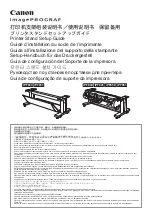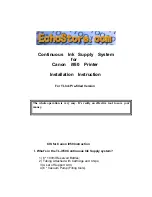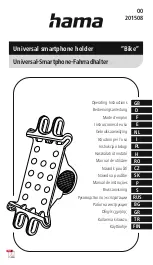
Important recommendations
■
Never allow an exposed flame or spark
near the batteries, particularly while
charging.
■
Never smoke while performing any
operation on the battery.
■
For protection, wear rubber gloves,
long sleeves, and appropriate splash
goggles or face shield.
■
The electrolyte is harmful to skin and
eyes. In the event of contact with skin
or eyes, wash immediately with plenty
of water. If eyes are affected, flush
with water, and obtain immediate
medical attention.
■
Remove all rings, watches and other
items with metal parts before working
on the battery.
■
Use insulated tools.
■
Avoid static electricity and take
measures for protection against
electric shocks.
■
Discharge any possible static
electricity from clothing
and/or tools by touching an
earth-connected part "ground" before
working on the battery.
1. Receiving the shipment
Unpack the battery immediately upon
arrival. Do not overturn the package.
Transport seals are located under the
cover of the vent plug. The battery is
normally shipped filled and ready for
installation.
■
Make sure all items have been received
by comparing with the packing list.
■
Check for damage or electrolyte
spillage. Report any irregularities
to the carrier and to Saft.
■
Remove the plastic transport seals. The
battery must never be used electrically
with the plastic transport seal in place
as this can cause permanent damage.
■
The battery is ready for installation.
2. Storage
Store the battery indoors in a dry, clean,
cool location (0°C to +30°C / +32°F to
+86°F).
■
Make sure that the transport seals
remain in place during storage.
■
Do not store in direct sunlight or
exposed to excessive heat.
■
A battery delivered charged (80 %) must
not be stored more than 3 months
(including transport).
If a charged battery has to be stored for
more than 3 months, discharge the cells
at 0.2 C
5
A down to 1V per cell or less.
SRA/SRA LT/SRA HT Ni-Cd Batteries
Installation and operating instructions
■
A battery delivered discharged and filled
may be stored for many years before it
is installed.
■
If storage is required prior to
commercial service, clean and coat the
metallic parts with a thin layer of neutral
Vaseline or neutral petroleum jelly
grease approved by Saft. Leave the
battery in its transport case to protect
from dust, moisture and short circuits.
3. Installation
Remove the transport seals and close the
vent plugs.
3.1.
Verify that cells are correctly
interconnected and that battery
connection to the load is also correct.
3.2.
Check tightness of terminal
connecting nuts. Torque applied must be:
• 10 ± 2 N.m for cells
SRA 75 to 140
SRA LT 75 to 140
SRA HT 70 to 130
• 30 ± 3 N.m for cells
SRA 160 to 375
SRA LT 160 to 375
SRA HT 150 to 350
The connectors and terminal nuts should
be corrosion-protected by coating with a
thin layer of neutral Vaseline or anti-
corrosion oil agreed by Saft.
3.3. Electrolyte
The electrolyte used is specific for each
product line:
- SRA
: E 10
- SRA LT : E 34
- SRA HT : Na 15 L
4. Commissioning
Caution:
during constant charging
operations, the battery box must be open.
4.1. The cells are delivered
80 % charged.
Charging and discharging should be done
at constant current.
■
For a battery stored less than
3 months at T< +30°C
No charge/discharge operation is
required before use.
■
For a battery stored for more than
3 months or at T>+30°C
• Discharge the battery at 0.2 C
5
A down
to an average 1V per cell.
• Maintain the battery in open circuit
during 8 hours or until the battery
temperature is between 10°C
and 30°C.
• Charge the battery at 0.2 C
5
A for
8 hours.
4.2. The cells are delivered discharged
Caution:
even if the battery is discharged,
there remains a residual charge that may
cause an electric shock.
Charging and discharging should be done
at constant current.
■
For a battery placed into service
immediately after delivery or after less
than one year of storage:
•
Constant current charge:
charge the
battery at 0.2 C
5
A for 8 hours
Caution:
during constant current
charging the battery box must be open
•
Constant voltage charge
: 1.55V/cell
for 20 h with the current limited
at 0.2 C
5
A
■
For a battery stored more than
1 year:
• Charge the battery at 0.2 C
5
A
for 8 hours.
• Discharge the battery at 0.2 C
5
A down
to an average 1V per cell.
• Maintain the battery in open circuit
during 8 hours or until the battery
temperature is between 10°C and
30°C.
• Charge the battery at 0.2 C
5
A
for 8 hours.
The battery is ready for use
5. Charging in service
■
1.47 V/cell at +20°C (+68°F) with
voltage compensation:
- 3 mV/°C/cell (-1.7 mV/°F/cell)
For higher charging voltages, consult your
local Saft representative.
6. Topping-up
Frequency of topping-up must be
determined for each battery. Topping-up
shall be performed every 6 months during
the first year in order to determine the
ideal topping-up interval which depends
on the charging voltage and actual use
of the battery.
Never let the electrolyte level fall below
the minimum level mark. Use only distilled
or deionized water to top-up.
The topping-up operation must be
carried on charged cells with a rest
time of minimum 2 hours.
November 2013




















